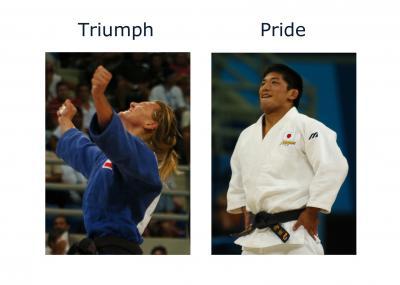When Olympic athletes throw up their arms, clench their fists and grimace after a win, they are displaying triumph through a gesture that is the same across cultures, a new study suggests. New findings due to be published in the journal Evolution and Human Behavior suggest this victory pose signals feelings of triumph, challenging previous research that labeled the expression pride.
"We found that displays of triumph include different behaviors to those of pride and occur more immediately after a victory or win," said David Matsumoto, professor of psychology at San Francisco State University. "Triumph has its own signature expression that is immediate, automatic and universal across cultures."
Matsumoto's latest findings come after his 2008 study of Olympic athletes, which suggested that expressions of pride and shame are universal and hardwired in humans. For his latest study, he investigated whether some of the expressions labeled as pride in his 2008 paper are more indicative of a separate emotion -- triumph.
Little research has been conducted on triumph as an emotion. Some psychologists believe triumph is a subset of pride, while Matsumoto's latest findings suggest triumph may be an emotion in its own right.
Participants in the study were shown photographs of judo competitors from 17 countries, who had just won a medal match at the 2004 Olympic Games, and were asked to judge the emotion portrayed by choosing an emotion from a list. The study included participants from two different cultures: the United States and South Korea. Separate research has found that South Korean culture is more hierarchical than the U.S., values collectivism more than individual achievement and rights and includes social rules that downplay displays of emotion.

Olympic athletes displaying expressions of triumph (left) and pride (right) after winning a medal match. These photographs were used in a new study, which suggests that the victory pose humans make after a contest or challenge (see left) signals feelings of triumph, challenging previous research that labeled the expression pride. The research, led by David Matsumoto, finds that nonverbal expressions of triumph (left) are universal across cultures, look different to displays of pride (right) and occur immediately after a win. Expressions of pride kick in a few seconds later.
(Photo Credit: Bob Willingham FRPS)
Across multiple studies, the observers consistently chose the same expressions as representations of triumph. In the photographs labeled triumph, athletes raised their arms above the shoulders, clenched their fists and their faces showed grimaces or mouths yelling. In the photographs labeled pride, athletes held their arms out from their body with their hands open, tilted their head back and their face showed a small smile.
"One of the biggest differences between triumph and pride can be seen in the face," Matsumoto said. "When someone feels triumphant after a contest or challenge, their face can look quite aggressive. It's like Michael Phelps' reaction after winning the 2008 Olympics. It looks quite different to the small smile we see when someone is showing pride."
Matsumoto says expressions of triumph are a declaration of one's success or performance whereas expressions of pride stem from feeling good about one's self, which requires time for self-evaluation. That may explain, says Matsumoto, why after a victory, expressions of triumph kick in before those of pride.
Analysis of the photographs of athletes used in the study revealed that triumph expressions occurred, on average, 4 seconds after the end of the judo match. Pride expressions occurred, on average, 16 seconds after the end of the match.
"Watch that immediate reaction in the first few seconds after an athlete has won their medal match – no matter what the sport is -- and you'll see this triumph response from athletes all around the world, regardless of culture," Matsumoto said.
The study suggests that displays of triumph may have an important role in evolution, perhaps by helping individuals signal status and dominance in early human societies.
Source: San Francisco State University